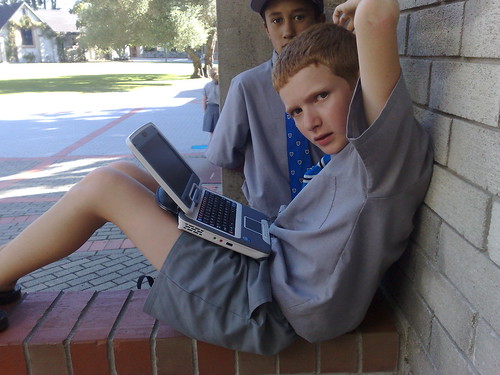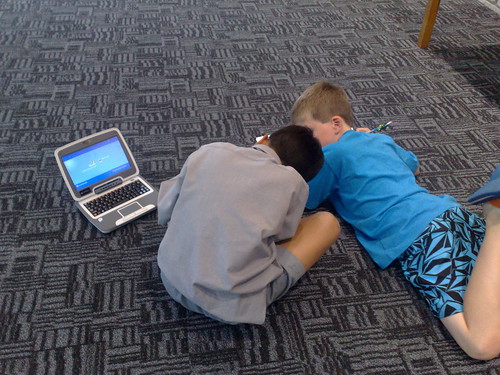Sunday, October 18, 2009
What Kids Are Doing - check 1 -
Wednesday, October 14, 2009
Reality Check - Digital Story

Wednesday, October 7, 2009
It's now and it's social if we let it
Missed the start of DK from mediasnackers workshop and came into with history of social interaction on the internet and then the Mobile/social learning onslaught.
Why are phones unwanted in schools? I am thinking especially camera in our school environment.
What about Kindy? See the 1 year old below
DK had an interesting digital story created by people writing on a4 and holding up their message and taking a picture
of it with the writer in the frame. .
My similar ideas for content
- What are the issues in our school?
- What helps you learn?
- I learn best when
- The book character was
- How does bullying effect people
- How does encouragement help you
- Also single frame digital story telling could come from these cameras
- sustainability messages
- Safety messages
- Poems
- Emotional responses
- Love more in comments below What do you think?
Milton Keynes youth service created the message below
This is simple but effective somehow knowing that the word was someone's makes it more powerful.
The second most popular reason youth use the web is Learning.
From the web makes me feel … This site collects and reflects on the results gathered from one ok DK's web interaction points.
I really liked this reflection on twitter
“Twitter not about contacting people about finding out about stuff”
DK was talking alot about the way things just are. You can use hash tags as a stream of information in twitter so why wouldn't you? it just is.
Very pragmatic I thought lets look at reality and what we can use around us. Simple tools and social networks.
As a 44 year old the infographic below made me feel so good I had won a competition that doesn't exist.
What do the baby boomers do in social media?
Link to Media Snackers is found above. DK is very open and inviting
jumps straight to honorary kiwi status in my book. 
Friday, September 25, 2009
Reading the right thing
This maybe what happens when people read this blog post. If not it probably because
we have chosen to or are seeking to learn about text vs visual language
through an emotional connection.
If from our perspective this is meaningful to us our brain will store it. I see visual information as more inately engaging.
Did the use of the red bold text get our attention? Is this a method of making the reading have more perceived benefit?
I plan to use visual text and prior reflection to help select what material, media, genre that students I work with will be exposed to.
Enthusiasm and engagement will need to be established before they start reading
Even better if they are part of the selection process it may help to ensure they predict benefit.
.
Wednesday, August 19, 2009
Reality Check 3
Working with Year Eight students on Digital storytelling aspects the following is the sketch of what and how we will work.
Most important part I think In the Session
- work out what we know
- have clear learning intentions
- interact with each other
- try to allow cognitive rehearsal for thinking
- create new personal knowledge
From an earlier collaboration with another teacher
the following are the learning intentions
What is a digital story ? Look at three of these on these sites.
http://lc.celebrateoklahoma.us/
http://seein2it.wikispaces.com/Digital+Storytelling
Activity
Give 1 get 1. Move around the room give someone an idea about
What a digital story is ? and
- Story like
- Emotional
- One person speaking
- Transition of pictures
- Similar to a movie
- Pictures of what it is about
- About a personal view of someone
- Past tense
- Music or Song
- Pictures are still
- Pictures and voice describing
What it Isn’t
- A movie
- Made up
- Moving pictures
- Voices out of pictures
- Just all facts
Look at a factual survival story
http://en.wikipedia.org/wiki/Uruguayan_Air_Force_Flight_571#The_crash_and_rescue
Fact to fake narration
The students came up with these ideas
- Good hook
- Tense : generally Past/flashback. Present .Future
- 1st person 3 rd Person
- Ending in a question (keep people wondering)
- Balancing fact and experience/emotions
- Diary form
- Suspense
- Point of view
Read the article highlight important facts perhaps collect facts as a group. the article is too big and needs to be reduced if one session is used for whole activity.
Write this as a narration
Reflect at end what was good learning what wasn’t any comment you would like to make.
Tuesday, June 23, 2009
Tinychat is big collaboration
Came across this from an oz/nz online meeting and think it ticks the right boxes.
My real respect for this comes from the lack of barriers to entry. This is a video conferencing space
that allows people to video chat with up to 8 participants and chat with upto 100 others. I tried to join a couple of rooms that were on Iran and the election. There was no one in them and I guess that shows that purpose is required and that we need a tinychat only when we need a chat. So when do we need one.
- When the people are far away and we know them but can’t be with them.
- When we are co-constructing a topic, event or experience
- When we are wanting feedback form an unbiased and neutral
- When creating home school partnership
- If we believe there is some extra learning and competencies being created as a result

Sunday, March 15, 2009
Netbooks are go.
We are always looking for technologies that enable learning and engage learners. We have this year initiated a 1 to 1 netbook programme for year seven students. I have never been happier in my beliefs that connected students will learn better. A bold statement I know but the students learning is evident both in the classroom and out. We have had to extend access to our social networking site elgg with over 100 concurrent connections to the database. This is becoming the hub of literacy development (see Below) as the community kicks in. Here I see Metcalfe's law showing true in education only with a few subtle differences. Metcalfe's law states that "the value of a telecommunications network is proportional to the square of the number of connected users of the system" Well the same can be said for learning value as more people connect the more we can learn from each other. The students are also empowered by knowing the other people they see on their network. I will ask some of them questions about this next week but first need to get a list of network beliefs off my Chest. Please add to this via comments.
Network value and function depends on:
- Number of people connected
- A feeling of ownership
- A feeling of engagement
- Network having multiple links student-teacher, Teacher-teacher, student-student, student-parent etc
- The ability of the network to support multiple concurrent connections which requires:
- High density Wireless provision
- High Speed internet provision
- Access to appropriate learning and social networks
- Anytime anywhere anyhow

Ownership and personalisation
The personalisation of the device comes from its size, connectivity and obviously belonging to the user. The photos I have taken around the school as I came across students and netbooks. All after class out of school.

Here We can see weekend engagement of students in the social network at Southwell School.
Thursday, March 5, 2009
Shozu mobile uploader
Wednesday, November 19, 2008
Change change change
Have added some new literacies below to add to this list
- Do we need to rethink every thing?
- Maybe not but we certainly need to question it?
- oral literacy
- media literacy
- visual literacy
- cultural literacy
- informational literacy
- environmental literacy
- operacy (see edward de bono)
add a quick comment if there is any thing feel would add to the timeline.
Monday, October 20, 2008
Face 2 Face has online down for count?
Wanting to reflect on what face to face and what online communication
and learning had to offer. I used the following to stir my thinking pot about it.
- The Face to Face curve
- Average retention rates Pyramid
- The Australian article about students saying no podcasts
The Face To Face Curve
While not dismissing online interactions this representation points to some thing special
happening in face to face environments. It makes some sense to me having just been to the big face to face of Ulearn08. I believe that huge learning that can happen when we txt, blog, read and comment within our personal learning networks. The people we are involved with in these
spaces are more filterable and subject to our moderation. The New Zealand educators in my learning network may get verified by f2f meetings but there can be an interaction richness long before this. It would lead me to think that f2f can provide alot but the essence of effective learning may come about from other nuances likely to exist in that environment.

Average Retention Rates

The average retention diagram (from USA's National Training Laboratory)has some other insights in my mind as to what we might look for to maximise learning.
Given the f2f curve's proposition that communication, capability and richness increase as we approach a f2f threshhold the average retention throws down a different perspective.
Much participatory and active learning achievement can come from engagement in online learning.
Even some physical achievements are virtualised and placed online as performances, document of construction and actual events.
In fact the face to face often is now recorded to become the digital artifact.
Many bloggers have posting as a part of a personal learning network that has perhaps more emotional engagement and nuance (perhaps stretching it) than we would expect.
Facilitating f2f meetings will bring most for these bloggers when the same discussion groups, teaching of others and practice by doing is afforded by the face to face experience.
(note this diagram has been ousted as a hoax)
Students say no to Podcasts
Which brings me to no wonder we have students saying no to the lack of inspiration, encouragement and isolation where online learning is not well constructed and understanding interaction richness.
Thursday, September 18, 2008
Visual literacy Reality check
I have interviewed Peter Walch an innovative teacher at Southwell School
about the impact of visual literacy on learning. Learners in Pete's class have told powerful stories with Visual Language driving the message. I asked Pete some questions about Visual Literacy and he came up with some interesting answers.
Video from 2007







